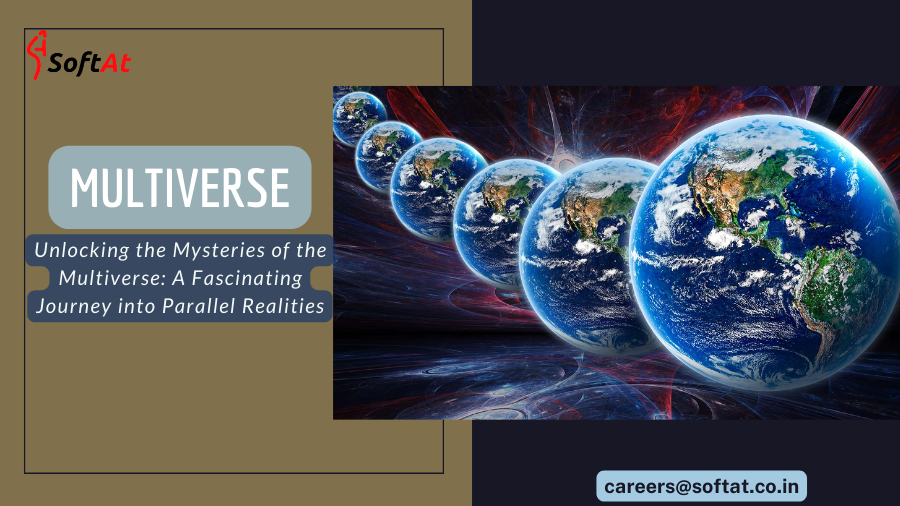Introduction: The concept of the multiverse has captivated the human imagination for centuries, sparking debates among scientists, philosophers, and science fiction enthusiasts. The idea that our universe might be just one of many parallel realities, each with its own laws of physics and possibilities, challenges our understanding of existence and the cosmos. In this blog, we embark on a captivating journey into the fascinating world of the multiverse, exploring its origins, theories, and the profound implications it holds for our understanding of reality.
Understanding the Multiverse:
Definition: The multiverse is a speculative concept in theoretical physics and cosmology, proposing the existence of multiple universes or parallel realities beyond our observable universe. Each of these universes may have different physical constants, dimensions, and fundamental laws, making them vastly diverse in nature.
Origins of the Multiverse Hypothesis:
a. Quantum Mechanics: In the early 20th century, quantum mechanics revolutionized our understanding of the subatomic world. It introduced the idea that particles exist in multiple states until observed, giving rise to the notion of multiple potential outcomes, each leading to a different universe.
b. Inflation Theory: Inflationary cosmology, proposed in the 1980s, suggests that the universe underwent an exponential expansion in its early stages. This theory implies that our observable universe might be just one bubble in a vast cosmic foam, with each bubble representing a separate universe.
c. String Theory and Brane Worlds: String theory, a candidate for the theory of everything, suggests that our universe may be one of many universes, existing on a higher-dimensional structure called a brane. The interactions between these branes could give rise to multiple universes.
Types of Multiverse:
a. Bubble Multiverse: Inflationary cosmology proposes the existence of a vast number of “bubble” universes, each undergoing its own expansion, with distinct physical laws and properties.
b. Many-Worlds Interpretation (MWI): In quantum mechanics, MWI suggests that every possible outcome of a quantum event actually occurs, leading to the creation of multiple universes where all possibilities manifest.
c. Landscape Multiverse: In string theory, the vast number of possible configurations of extra dimensions and physical constants creates a “landscape” of universes, each representing a different set of parameters.
Implications and Controversies:
a. Cosmic Significance: The existence of a multiverse has profound implications for the anthropic principle, suggesting that our universe’s specific physical laws and constants might be a product of chance rather than design.
b. Parallel Lives: The MWI raises the intriguing possibility that every decision we make could result in branching realities, where different versions of ourselves exist in parallel universes.
c. Fine-Tuning and Anthropic Principle: The multiverse hypothesis addresses the “fine-tuning problem” of the fundamental constants of the universe. Critics argue that invoking the multiverse to explain fine-tuning raises new questions about the statistical likelihood of life.
d. Observable Evidence: The multiverse remains a theoretical concept, with limited empirical evidence. Some argue that the existence of a multiverse might be beyond the scope of current scientific observation.
Science Fiction and the Multiverse:
The concept of the multiverse has been a recurring theme in science fiction literature, television, and movies. It has inspired imaginative storytelling, exploring parallel realities, time travel, and alternate histories.
Philosophical Implications:
The multiverse hypothesis challenges our understanding of reality, causality, and the nature of existence. It raises profound philosophical questions about the nature of consciousness, free will, and the boundaries of reality.
Conclusion:
The multiverse, a captivating concept that transcends the boundaries of science and imagination, continues to intrigue and challenge our understanding of the universe and our place within it. While the idea of parallel realities and multiple universes remains speculative, it stimulates scientific curiosity and philosophical contemplation.
As our understanding of quantum mechanics, cosmology, and theoretical physics advances, the multiverse hypothesis may evolve from speculative theory to a profound revelation about the fundamental nature of reality. Until then, the multiverse remains a fascinating and mysterious realm, inviting us to explore the infinite possibilities that lie beyond the boundaries of our observable universe.
For SAP & Oracle Consulting services you can click here.
For SAP Managed Services you can click here.





